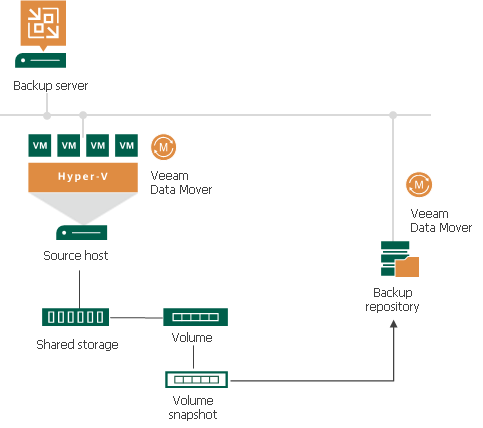主机上备份
During on-host backup, VM data is processed on the source Microsoft Hyper-V host where VMs that you want to back up or replicate reside. All processing operations are performed directly on the source host that performs the role of the backup proxy. For this reason, on-host backup may result in high CPU usage and network overhead on the host system.
Note |
The procedure below describes the backup process for Microsoft Hyper-V Server 2012 R2 and earlier. For more information about backup of VMs registered on Microsoft Hyper-V 2016 and later versions, see Online Backup and Crash-Consistent Backup. |
The on-host backup process is performed in the following way:
- Veeam Backup & Replication triggers a snapshot of the necessary volume.
- Veeam Data Mover on the host uses the created volume snapshot to retrieve VM data; it processes the VM data and copies it to the destination.
- After the backup process is complete, the volume snapshot is deleted.

Assigning Role of On-Host Backup Proxy in CSV
The role of the backup proxy is assigned to a Microsoft Hyper-V host in CSV by the following rules:
- If you back up or replicate VMs whose disks are located on a CSV in Microsoft Hyper-V Server 2012 or 2012 R2, and Microsoft CSV Software Shadow Copy Provider is used for snapshot creating, Veeam Backup & Replication assigns the role of an on-host backup proxy to the host owning the CSV. If VM disks are located on different CSV's, Veeam Backup & Replication may use several on-host backup proxies, which are the corresponding hosts owning CSV's.
- In case you perform backup or replication of VMs whose disks are located on a CSV in Microsoft Hyper-V 2008 R2, and a VSS software or hardware provider is used for snapshot creation, Veeam Backup & Replication assigns the role of an on-host backup proxy to the host on which the processed VM is registered.
Related Topics